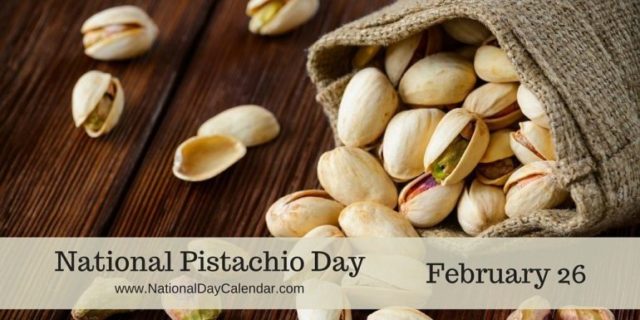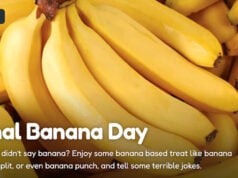
February 26th recognizes all things pistachio. It’s National Pistachio Day! It is a day that has been set aside for all pistachio lovers to eat their favorite nut all day long. For those who do not eat pistachios, buy some and give them to someone who does. Crack them open and eat them up or enjoy them in ice cream or your favorite pistachio dessert!
Pistachios arrived in the United States sometime in the 1880s, but they have been cultivated in the Middle East since Biblical times.
The pistachio tree grows to about 20 feet tall needing little or no rain and must have high heat. In Iran, they claim they have pistachio trees still living that are 700 years old! A new tree takes between 7 and 10 years to mature and bear fruit.
Pistachio Facts:
- All pistachio shells are naturally beige in color. Some companies dye nuts red or green if nuts are inferior or for consumer demand.
- California produces about 300 million pounds of pistachios each year, accounting for 98 percent of America’s production.
- Pistachio shells typically split naturally when ripe.
- The kernels are often eaten whole, either fresh or roasted and either salted or unsalted.
- In the Middle East, people call the pistachio the smiling nut.
- In China, people call the pistachio the happy nut.
Health Benefits
“Pistachios are an excellent source of vitamin B6, copper and manganese and a good source of protein, fiber, thiamine and phosphorus. Scientific evidence suggests but does not prove that eating 1.5 ounces (42.5g) per day of most nuts, such as pistachios, as part of a diet low in saturated fat and cholesterol, may reduce the risk of heart disease.” US Food and Drug Administration, July 2003
A Great Thing To Do — Recycle the Pistachio Shells!
The empty pistachio shells are useful for recycling in several ways. If unsalted, the shells need not be washed and dried before reuse, but washing is simple if that is not the case. Practical uses include as a fire starter; kindling to be used with crumpled paper; to line the bottom of pots containing houseplants for drainage and retention of soil for up to two years; as a mulch for shrubs and plants that require acid soils, as a medium for orchids; and as an addition to a compost pile designed for wood items that take longer to decompose than leafy materials (it can take up to a year for pistachio shells to decompose unless soil is added to the mix). Shells from salted pistachios can also be placed around the base of plants to deter slugs and snails. Many craft uses for the shells include holiday tree ornaments, jewelry, mosaics and rattles. Research indicates that pistachio shells may be helpful in cleaning up pollution created by mercury emissions.
- Pistachio nuts are a member of the cashew family and are closely related to mangos, sumac, and even poison ivy.
- Iran produces more pistachios than any other country in the world with over 200k tons per year.
- Male pistachio trees are alternate bearing, meaning they produce heavier crops every other year.
- Pistachios are one of the oldest flowering nut trees, and are one of the only two nuts mentioned in the Bible (Genesis 43:11). Humans have eaten pistachio nuts for at least 9,000 years.
- According to legend, pistachios were featured in the fabled Hanging Gardens of Babylon, built about 700 B.C. by King Nebuchadnezzar for his wife Amytis.
- In the first century A.D., Emperor Vitellius introduced Rome to the pistachio. Apicius, Rome’s Julia Child of the first century, includes pistachios in his classical cookbook.
- Perhaps a true royal nut, the Queen of Sheba loved pistachios. In fact, she demanded that the entire region’s pistachio harvest be set aside for her.
Sources:












